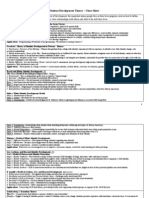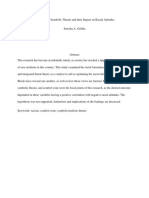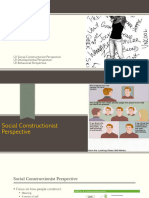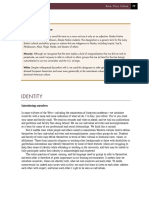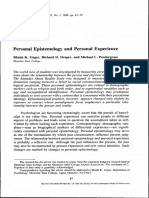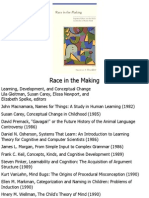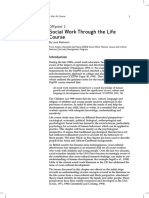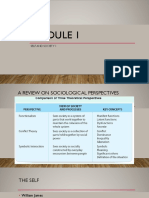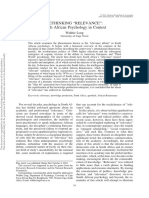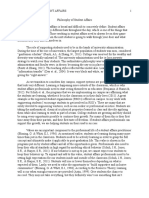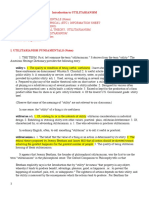The looking lens through a rigorous liberal arts private
institution
By: Lindsay Gove
Gerica Lee
�Womens Way of
Knowing
Belenky, Clinchy, Goldberger and Tarule
�Womens Way of Knowing
Belenky, Clinchy, Goldberger and Tarule
Cognitive Theory
Women students often doubted their intellectual abilities.
Women did not feel included in academic environments.
Women were found to focus more on the lessons they learned through
their relationships with friends, teachers and their community.
�Five Epistemological Perspectives
1.Silence: authority is all-powerful, good vs. bad
2.Received Knowledge: all of the right answers are received from the
authorities
3.Subjective Knowledge: loss of trust in male authority, want their
views affirmed
4.Procedural Knowledge: truth is obtained through observation and
experiences
5.Constructed Knowledge: student combines all of their knowledge to
form their views
�Findings
Research:
Study of student-faculty interaction found support for the importance of validation,
support, and sense of connectedness for womens intellectual and personal
development (Latter et al., 2005).
Application:
Connected teaching does help women nurture their own voices (Belenky et al., 1986).
Teaching = Midwife (giving birth to their own ideas) (p.217)
Providing effective mentoring
�Epistemological Perspectives Vs. BID
Silence: characterized as mindless, voiceless, and obedient
An Example: Low enrollment rates of African American Women at K College
Nigrescence by William Cross (1971 & 1995)
A series of experiences and that re-socializes
Black Identity Development by
a persons preexisting non-Afrocentric identity
Jackson (1976 & 2001)
into an Afrocentric one (Torres et al., 2003, p. 41).
The BID framework introduced
Stage One- Naive (BID)
little or no conscious of social awareness amongst
the levels/stages of
own race.
consciousness that people of
vulnerable to the logic system and worldview of social agents (such as parents, friends, teachers,
color tend to follow in the
media and etc. )
development of their racial/black
identity (Jackson, 2012).
�Epistemological Perspectives Vs. BID
Received Knowledge: one is capable of receiving and reproducing knowledge imparted by external authorities, but
not of creating knowledge on ones own (Belenky et al.,1986).
An Example: African American Women seeking support and guidance through the means of what their peers are
suggesting -listening to the voices of others
Stage Two: Acceptance (BID)
The internalization of conscious or unconscious, of an ideology of racial dominance and subordination which
touches all facets of ones private and public life (Jackson, 2012).
Focus primarily on the effect of racism on the experience
White is Right
approval, sense of worth, goods, power and money
Active Acceptance
�Epistemological Perspectives Vs. BID
Subjective Knowing:
(Belenky et al., 1986)
residing in self for the truth; loss of male authority figure
An Example: Women of Color having a bad experience with a male faculty/staff member providing
advice or truly understanding the student concerns.
Walking away from the past
Stage Three: Resistance (BID)
To understand and recognize racism in its complex and multiple manifestations- at the individual
and institutional, conscious and unconscious, intentional and unintentional, attitudinal, behavioral
and policy levels (Jackson, 2012).
Covert and overt impacts
White Privilege
Emotions: Anger, pain, hurt and rage
�Epistemological Perspectives Vs. BID
Procedural Knowing: truth is obtained through observation and experiences
Two Approaches:
Separate Knowing= doubting
Connected Knowing= believing (personal experiences)
grounded in empathy and care
An Example:
Experiences through the lens of a different race (doubting)
Experiences from someone similar- race/gender (believing)
Stage Four: Redefinition (BID)
Concern of defining oneself in terms that are independent of the perceived strengths and/or weakness of the dominant group (Jackson, 2012).
Interaction with whites are not as necessary and useful
Focuses on embracing the black culture
�Epistemological Perspectives Vs. BID
Constructed Knowing: the integration of subjective and objective knowledge, with both feeling and
thought present (Belenky et al., 1986).
An Example: Women of Color finding themselves; sense of belonging; knowing who you are as an
individual
It is in the process of sorting out the pieces of the self and of searching for a unique and authentic
voice (Belenky et al., 1986, p. 137).
Stage Five: Internalization (BID)
Being able to apply or integrate some newly found aspects of the Black culture.
No need to explain, defend or protect their identity
Multicultural perspective
Intersectionality (bi-racial, wage gaps, etc. )
�Racial and Ethnic Identity
Development
�The Evolution of Identity Development
Identity theories evolved from earlier theories that were considered lifespan and psychosocial in nature
referred to as ego development theories
experiences shape who you become
Theoriest:
Erickson (best known)
Loevingers
Kegan
Three Major Themes:
role of late adolescence
influence of historical and cultural aspects
processes beyond the adolescent years
�Racial Identity Theories
Social identities influence who we are, how we see ourselves and how we relate to
others (Reynolds, 2001).
aspects include race, social class, gender, sexual orientation, religion, language,
abilities, and age and others as well
Hardiman and Jackson (1997) developed a social identity theory focus across groups.
found in other identity theories
Stages: naive, acceptance, resistance, redefinition, and internalization
�Racial Identity Theories (Continued)
Black Identity Theories
the processes that explain the way a person thinks, feels and acts in reference to
being Black (Cross & Vandiver, 2001)
White Identity Theories
focus on the understanding and acknowledgement of privilege that comes from
being in the majority (Helms, 1990)
Multiracial Theories
beginning with the childhood and with the individual's recognition of growing up in a
multiracial home
�Ethnic Identity Theories
Framework revolves around social identity theory, acculturation and cultural
conflict, and identity formation (Phinney, 1990).
Social Identity= encouraging individuals to be a part of the majority group
Acculturation/Cultural Conflict= minority (or immigrant) relates to the dominant majority
culture
Identity Formation=acknowledges the dynamic nature of ethnic identity and influences that
occur as a result of time and context (Phinney, 1990).
Asian American Identity Theories
Latino Identity Theories
American Indian-Native American Identity Theories
�Findings
Critical Race Theory (CRT)
explains the centrality of race and ethnicity while emphasizing the influence of culture on identity.
Three Principles:
1. Deconstruction of structures that oppress is necessary to understand how they
influence others
2. Reconstruction for the value of every human being is critical
3. construction of a society with equal power among all is involved is valued (Ladson
Billings, 1998).
There is no such thing as color-blind research, and that not recognizing race, ethnicity as well as
other social identities, furthers inequality within society (Parker, 1998).
�LGBTQ Identity
Development
�History of LGBTQ
1970s was the start of the idea of sexual orientation and same-sex attraction
as not an illness but but a development.
Studies have shown that as many as 10% of all college students identity as
gay, lesbian, bisexual or questioning.
3 Major Identity of Sexual Orientation Identity
Cass
Fassinger
DAugellis
�Cass Model of Sexual Orientation Identity
Formation
Six stages of perception and behavior
Prestage 1
Stage 1-Identity Confusion
Stage 2-Identity Comparison
Stage 3-Identity Tolerance
Stage 4-Identity Acceptance
Stage 5-Identity Pride
Stage 6-Identity Synthesis
�Cass Model of Sexual Orientation Identity
Formation Cont.
Critique:
Models reflect social and political forces of the 1970s
Failed to differentiate personal identity development from
development of sexual orientation
Strong research
Mostly centered around gay white men
�Fassingers Model of Gay and Lesbian Identity
Development
Theory: Two Parallel Processes
Sexual Identity
Group Membership Identity
Each has four phases
Awareness
Exploration
Deepening/Commitment
Internalization/synthesis
�Fassingers Model of Gay and Lesbian Identity
Development Cont.
Research: Studied 38 lesbians and 34 gay men
Application: Gay and lesbians individuals maybe in different places with
regard to their individual and group identity
�DAugellis Model of Lesbian, Gay and Bisexual
Development
Three sets of interrelated variables that identify formation
Personal Subjectives and Actions
Interactive intimacies
Sociohistorical Connections
Identity Development Process
Exiting Heterosexual Identity
Developing a personal identity status
Developing a social identity
Becoming a lesbian/gay/bisexual offspring
Developing a intimacy status
Entering a community
�Kalamazoo College, Admissions
Suzanne Lepley
Senior Associate Director of Admissions
B.A. in social work and organizational communication
Been at K-College for 18 years
�Kalamazoo College, Academic Advising/Residence Life
Interviewee: Dana Jansma, Associate Dean of Students
Problem: Mental Health Issues (Anxiety + Stress + Depression= High Achieving Students)
Family
Work
Social Life
School
College students mental health problems are becoming more
common, more problematic and a much larger focus on college
and university campuses (Benton, 2006, p.4).
K College Resources/Strategies:
Recreation Center
Midnight Breakfast
Counseling Office (treatment,medication, consultation, relapse prevention, support)
Sleep (Anxiety and Depression Association of America, 2015)
Talk to Someone (Anxiety and Depression Association of America, 2015)
�First-Year Seminar, K College
First Year required to be enrolled in seminar (Writing intensive-1st Term)
Programs (time management, stress, alcohol abuse, and etc. )
Professors are assigned to teach the course.
One professor; two advisors, 1-2 peer leader per class
12-15 first year students in seminar class
Early Alert:
Referrals to counselors (advisors)
Forms online (Staff/faculty)
All reports goes to Academic Advisors
If severe
Schedule a meeting with student
Security
Let RAs know
its vital that all student affairs practitioners
understand these concerns and what impact they
have on the academic, social, and psychological
well-being of students (Benton, 2006, p.4).
�Residential Life at Kalamazoo College
Interviewee: Jake Lemon, Area coordinator of Crissey, Severn and
Trowbridge Halls
Services for First-Year students
First-Year Seminars
RA-Required to put on educational programs per quarter
Bi-weekly Friday reflections
�Resources
American College Health Association (ACHA). (2006). Reference group executive summary. Retrieved August 10, 2007, from www.acha-ncha.org.
Anxiety and Depression Association of America (ADAA). (2015). Reference group executive summary. Retrieved November, 7th, 2015, from www.adaa.org.
Benton, S. A. (2006). The scope and context of the problem. In S. A. Benton & S. L. Benton (Eds.), College student mental health: Effective Services and strategies across
campus (pp. 1-14).
Chickering, A. W., & Reisser, L. (1993a). A current theoretical context for student development. In A. W. Chickering & L. Reisser, Education and identity (2nd ed., pp. 1-41).
San Francisco, CA: Jossey-Bass.
JACKSON III, B. W. (2012). Black identity development. New Perspectives on Racial Identity Development: Integrating Emerging Frameworks, 33.
Reynolds, A. L. (2001). Embracing multiculturalism: A journey of self-discovery. In J. G. Ponterotto, J. M. Casas, L. A. Suzuki, & C. M. Alexander (Eds.) Handbook of
multicultural counseling (pp. 103-112). Thousands Oaks, CA: Sage.
Torres, V., Howard-Hamilton, M., & Cooper, D. L. (2003). Identity development of diverse populations: Implications for teaching and practice (ASHE/ERIC Higher
Education Report, Vol. 29). San Francisco: Jossey-Bass.
Renn, Krisitn. (2010). LGBT and Queer Research in Higher Education: The state and status of the field. Michigan State University Educational Researcher, Vol. 39, No. 2.
